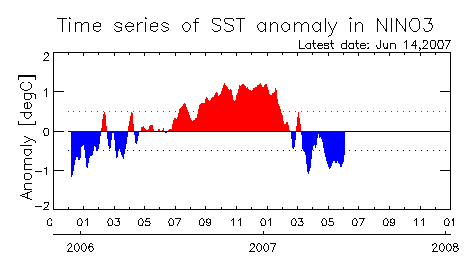| |
On June 11, 2007, the Japan Meteorological Agency (JMA) announced the possibility that a La Niña phenomenon had occurred and that this condition would continue until autumn. "Seen from Space" has often reported the beginning and end of El Niño and La Niña events. The sea-surface temperature offshore of Peru in South America fluctuates in a cycle of several years, but this is not abnormal in itself. However, some people believe such fluctuation is one of the causes of the abnormal climate since it influences the world climate including the tropical zone.
 |
| Fig. 1 Deviation of sea-surface temperature in El Niño monitoring area |
Figures 1 illustrates the deviation of the sea-surface temperature distribution in the El Niño monitoring area as observed by AMSR-E on board NASA's Aqua. It shows a period of low temperature continuing from this spring.
 |
| Fig. 2 Deviation from 30-year average of sea-surface temperature, averaged over a five-day period (December 28, 2006 to January 1, 2007) |
 |
| Fig. 3 Deviation from 30-year average sea-surface temperature, averaged over a five-day period (June 10 to June 14, 2007) |
Figures 2 and 3 illustrate the deviation of the sea-surface temperature distribution (observed by AMSR-E) from the last 30-year average. Figure 2 depicts the deviation this January; Fig. 3 depicts the deviation this June. In Fig. 2, the El Niño monitoring area (the black-edged area in Figs. 2 and 3) is red, indicating temperatures above average; in Fig. 3, the area is blue, indicating temperatures below average.
La Niña events tend to emphasize seasonal aspects so that when a La Niña event occurs in summer, it tends to be very hot near Japan.
If this is correct, we will hear the term "Intense Heat Day (Day with maximum temperature exceeding 35°C)" utilized several times by JMA this year. You are likely to become familiar with this term sooner than you expected.
Explanation of the images:
Figs. 2 and 3
| Satellite: |
Aqua (NASA) |
| Sensor: |
Advanced Microwave Scanning Radiometer for EOS-Aqua (AMSR-E; JAXA) |
| Date: |
December 28, 2006 to January 1, 2007 (Fig. 2)
June 10 to June 14, 2007 (Fig. 3) |
|
 |
|







